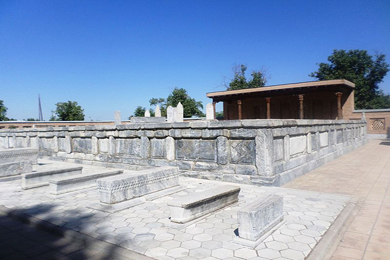Yalangtush Bahadur also Zhalantos Bahadur (in the world oriental tradition Yalangtush Bahadur), (1576, Nurata, Bukhara Khanate - 1656, Samarkand, Bukhara Khanate) - military leader, Biy, politician, ruler of a large inheritance, governor (emir) of the Bukhara khans. His name seems to be a lifetime nickname, a variation of the name "Yalangtush Bahadur" literally translates as "a hero with an open chest." Origin: According to one version, Zhalantos was born in the Syr Darya lands in 1576, in the clan nomads of the Kazakh clan Tortkara (Alimuly tribe).
This is the territory of the modern Kazalinsky district of the Kyzylorda region. The father of Zhalantos Seytkul-kazi, was a wealthy and influential man in these lands, enjoyed great authority. The territories of modern Uzbekistan were part of the nomad tribe of the Alimula tribe. In 1581, Shigay Khan and the father of Zhalantos Seytkul migrated to the mountains of Nurata near Bukhara. He is the cousin of Aiteke Bi. According to other sources, Yalangtush Bahadur came from a kind of greed, and his father was named Boy Khoja. Father and son were students of Khoja Khoshim Dagbedi, a descendant of the famous Sufi leader of the Naqshbandi direction, Mahdumi Azam (1461-1542). Yalangtush Bahadur and his daughters (Iclima bonu, Oybibi) were buried in the cemetery in Dagbit at the feet of Khoj Hoshim Dagbedi. According to a document from 1643, he had a son Boybek, who was also literate. However, he died before his father, in a document from 1650 they write that he died. Also, Russian authors, both pre-revolutionary and Soviet, call Yalangtush Bahadur an Uzbek commander. In particular, A.P. Khoroshkhin: Tilla-Kari and Sher-Dar were built more than 200 years ago by the ruler of Samarkand, Yalang-biy or Yalang Tash-bahadur, for the money and treasures he plundered in the city of Mashad, in Persia. Yalang-Tash (smooth stone) was an Uzbek from the tribe of Alchin D.I. Evarnitsky: The Tilla-Kari mosque was built in 1618 by the Christian era, Yalangtush Bagadur from the Uzbek family of Alchin. The Shir-Dar mosque was built in 1616, according to Abu-Tagir-Khoja, named above Yalangtush Bagadur, from the Uzbek family of Alchin, and is the most magnificent building of all three mosques standing on the Registan. V. I. Masalsky: The Tilla-Kari mosque and madrasah (that is, gilded) was built in 1647 by the emir Yalangtush-bahadur (commander of Imam-Kulikhan) from the Uzbek family “Alchin”. To the right of Tilla-kari, at a right angle to it, is the Sher-Dor mosque (that is, decorated with lions), founded in 1618 by the same emir Yalangtush P. P. Ivanov writes: The decline of the political significance of the Ashtarkhanids in Bukhara was accompanied by an increase in military political power of individual Bukhara feudal lords from among the Uzbek nobility, which included, for example, the famous dignitary (atalyk) Khan Abdul-Aziz (1645-1680), Biy Yalantush, the builder of the famous Samarkand madrasahs Shir-Dar and Tilla-kari. The discussion is the name of the father Yalangtush Bahadur, because according to Kazakh oral legends his father’s name sounds like Seyitkul, and according to written legal documents, his father’s name was Boyhodzha. Most likely, we are talking about two different faces. Zhalantos Batyr left numerous offspring, and Yalangtushbiy had only one son, who died without leaving male offspring.




